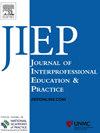Opportunities to improve the medical education experience in an interprofessional educational Setting: An application of concept mapping
Q3 Social Sciences
Journal of Interprofessional Education and Practice
Pub Date : 2025-07-19
DOI:10.1016/j.xjep.2025.100759
引用次数: 0
Abstract
Background
The Interprofessional Partnership to Advance Care and Education (iPACE™) model was developed and piloted on an Internal Medicine (IM) unit at Maine Medical Center to promote interprofessional care and education. Although there were many benefits of this care model, residents had multiple concerns that limited model acceptance. Concept Mapping (CM) was identified to further explore, understand, and address these concerns.
Objectives
CM was applied to explore IM resident and faculty perceptions of what would make IP experiences, such as iPACE™, more valuable to increase their acceptability.
Methods
Sixty-four IM faculty and residents were recruited. They completed the following statement: “Interprofessional educational experiences, such as iPACE™, add more value to medical education when _______”. Following the CM steps, the study utilized 2 online surveys and 2 focus groups.
Results
Response rates for two surveys were 38 % and 23 % and focus groups were capped at 15 participants. The 43 generated statements were grouped into 5 clusters and participants named them as follows: (1) Building systems that promote efficiency, (2) Values patient/care team wellbeing, (3) Dynamic and engaging interprofessional team rounds, (4) Supportive education integrated into daily experience for all, and (5) Setting expectations for experiential and formal education. Cluster 1 was rated as having highest importance with an average of 4.5/5 and statements in this cluster focused on resources and processes that make rounds more efficient, flexible, and effective.
Conclusion
This study suggests that IM residents and faculty value IP educational experiences when there is faculty buy-in and when they minimize perceived care inefficiencies and administrative burdens.
在跨专业教育环境中改善医学教育经验的机会:概念图的应用
促进护理和教育的跨专业伙伴关系(iPACE™)模式在缅因州医学中心的内科(IM)部门开发和试点,以促进跨专业护理和教育。虽然这种护理模式有很多好处,但住院医生有多种顾虑,限制了这种模式的接受。概念映射(CM)被确定为进一步探索、理解和处理这些关注点。目的:本研究旨在探讨如何使iPACE™等知识产权体验更有价值,从而提高其可接受性。方法招募64名IM教师和住院医师。他们完成了以下声明:“跨专业教育经验,如iPACE™,为医学教育增加了更多价值,当_______ ”。遵循CM步骤,该研究使用了2个在线调查和2个焦点小组。结果两项调查的回复率分别为38%和23%,焦点小组的参与者上限为15人。生成的43个陈述被分成5组,参与者将其命名为:(1)建立提高效率的系统,(2)重视患者/护理团队的福祉,(3)充满活力和参与的跨专业团队轮次,(4)将支持性教育融入所有人的日常体验,以及(5)设定体验和正规教育的期望。第1组被评为最重要的,平均得分为4.5/5,该组中的陈述侧重于使回合更高效、更灵活和更有效的资源和流程。结论本研究表明,当有教师参与时,当他们最大限度地减少感知到的护理效率低下和行政负担时,住院医师和教师更重视知识产权教育经验。
本文章由计算机程序翻译,如有差异,请以英文原文为准。
求助全文
约1分钟内获得全文
求助全文
来源期刊

Journal of Interprofessional Education and Practice
Social Sciences-Education
CiteScore
1.60
自引率
0.00%
发文量
80
期刊介绍:
Journal of Interprofessional Education & Practice, a quarterly online-only journal, provides innovative ideas for interprofessional educators and practitioners through peer-reviewed articles and reports. Each issue examines current issues and trends in interprofessional healthcare topics, offering progressive solutions to the challenges facing the profession. The Journal of Interprofessional Education & Practice (JIEP) is affiliated with University of Nebraska Medical Center and the official journal of National Academies of Practice (NAP) and supports its mission to serve the public and the health profession by advancing education, policy, practice & research.
 求助内容:
求助内容: 应助结果提醒方式:
应助结果提醒方式:


